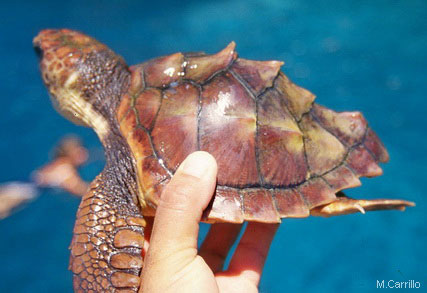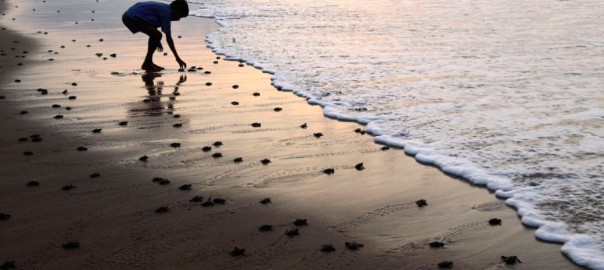The Loggerhead Turtle or Caretta caretta is one of the 7 species of sea turtles spreading in warm, tropical and subtropical water oceans in the world, and one of the exceptional visitors of our coasts which we sometimes are lucky to come across in our trips from Corralejo to the islet of Lobos.
Sea turtles are prehistoric reptiles which date back 200 million years according to some fossil records, although the species we know nowadays just date back 10-60 million years. They outlived their neighbours, the big dinosaurs.
Their main characteristic, common to all the sea turtle species, is the presence of a bony shell, formed by a carapace — upper part— and a ventral shell —lower part— covering all the guts very effectively, leaving enough room to let the head, extremities and tail out. These huge sea reptiles are well adapted to living in the sea (some male specimens can spend hours under water), but they keep needing air to breath and land in the breeding season.
The Loggerhead turtle or Caretta Caretta, also known as “Caguama” turtle, got this name due to the large size of its head, as compared to the rest of sea turtles.
Distribution
They spend most of their life in the sea, in surface waters near the coast, around 13,3º and 28º.
Caretta caretta is the most cosmopolitan of all the sea turtles, and it’s spread all over the Atlantic, Indian, Pacific Oceans and the Mediterranean Sea, with a highest representation in the Southeast Coast of Northern America (Florida is the site where you can find the highest number of nests, more than 67.000 per year) followed by the coast of the Arabian Peninsula in the Indian Ocean, and the Western Coast of Australia.
In the Canary Islands, it’s the most relevant species we have and find all through the year, being mainly abundant in Spring and Summer. And as we have already said, sometimes it’s an exceptional travel companion in our boat trips from Corralejo.
Family
Although there aren’t many data about sea turtles in general, as they are long-lived species with a very complex life-cycle, it’s known that Caretta caretta belongs to the Cheloniidae family, which dates back 40 million years. This family is shared by 5 more species: The Ridley turtle, The Olive Ridley turtle, The Hawksbill turtle, The Flatback sea turtle and the Green sea turtle; most of them are endangered species.
Morphology and identification
The Loggerhead turtle features the biggest hard shell of all the species (70-95cms.) Adult male specimens weigh among 80-200kgs, although there are records of 500kg specimens, and longer than 200cms.
It’s usually brown, with reddish shades, and a yellow hue is most common in edges and the ventral shell.
It features tear glands, behind the eyes, through which it gets rid of the excess salt they ingest when swallowing sea water. This makes it look, when it’s on earth, as if it were crying.
In young specimens it’s impossible to distinguish the sex through their external appearance. Adults feature some differences: males have a bigger head, longer tails and claws, shorter ventral shell and less curved carapace than females’.
They are omnivorous and they feed specially on marine invertebrates, but they also have strong jaws which allow them to crush crabs and molluscs.
Breeding
One characteristic of this species, which keeps it bound to the land, is the need of females to approach the coast in order to dig their nests and lay their eggs there. It’s a species with a low breeding rate, as females apart from reaching their sexual maturity between the 17 and 33 years (they live between 47 and 67 years) they only lay eggs every two or three years. Moreover, out of all the eggs that hatch very few of them become adults.
For this reason, apart from the fact that many nesting beaches have disappeared, that many specimens die entangled in fishing gears, strangled in trawls, caught in plastic waste…, the Loggerhead turtle is considered an endangered species.

“El Proyecto Tortuga” exists In Fuerteventura since the year 2009, trying to reintroduce in The Islands a species that disappeared from our coasts 300 years ago by translocating Loggerhead’s eggs from Cape Verd.
The beach in charge of taking in these nests is “La Playa de Cofete”, in the South of the Island. The first year more than 500 turtles were born, which proved the excellent conditions of this beach to carry out such a project.
In our next article we’ll discuss this project in detail, a project which tries to contribute to the preservation of this species at a global level
FuerteCharter’s Team.
